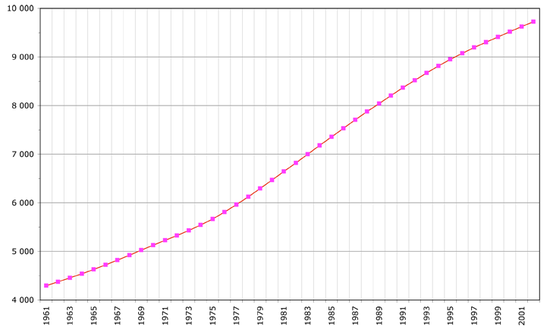Demographics of Tunisia
2007 Schools Wikipedia Selection. Related subjects: African Geography
While the vast majority of modern Tunisians identify themselves as Arabs, they are mainly the descendants of Berbers, and to a lesser extent of and Arabs: less than 20% of the genetic material comes from the Middle East . In addition people from numerous civilizations that have invaded, migrated to, and been assimilated into the population over the millennia.
Recorded history in Tunisia begins with the arrival of Phoenicians, who founded Carthage and other North African settlements in the 8th century BC. Carthage became a major sea power, clashing with Rome for control of the Mediterranean until it was defeated and captured by the Romans in 146 B.C. The Romans ruled and settled in North Africa until the 5th century when the Roman Empire fell and Tunisia was invaded by European tribes, including the Vandals. The Muslim conquest in the 7th century transformed Tunisia and the make-up of its population, with subsequent waves of migration from around the Arab and Ottoman world, including significant numbers of Spanish Moors and Jews at the end of the 15th century. Tunisia became a centre of Arab culture and learning and was assimilated into the Turkish Ottoman Empire in the 16th century. It was a French protectorate from 1881 until independence in 1956, and retains close political, economic, and cultural ties with France.
Nearly all Tunisians (98% of the population) are Muslim. There has been a Jewish population on the southern island of Djerba for 2000 years, and there remains a small Jewish population in Tunis which is descended from those who fled Spain in the late 15th century. There is a small indigenous Christian population. Small nomadic indigenous minorities have been mostly assimilated into the larger population.
Population: 10,074,951 (July 2005 est.)
Age structure:
0-14 years: 25.3% (male 1,316,308; female 1,234,309)
15-64 years: 68.1%(male 3,437,880; female 3,418,591)
65 years and over: 6.6% (male 321,287; female 346,576) (2005 est.)
Population growth rate: 0.99% (2005 est.)
Birth rate: 15.5 births/1,000 population (2005 est.)
Death rate: 5.09 deaths/1,000 population (2005 est.)
Net migration rate: -0.54 migrant(s)/1,000 population (2005 est.)
Sex ratio:
at birth: 1.07 male(s)/female
under 15 years: 1.07 male(s)/female
15-64 years: 1.01 male(s)/female
65 years and over: 0.93 male(s)/female
total population: 1.02 male(s)/female (2005 est.)
Infant mortality rate: 24.77 deaths/1,000 live births (2005 est.)
Life expectancy at birth:
total population: 74.89 years
male: 73.2 years
female: 76.71 years (2005 est.)
Total fertility rate: 1.75 children born/woman (2005 est.)
Nationality:
noun: Tunisian(s)
adjective: Tunisian
Ethnic groups: Arab and Berbers 98%, European 1%, Jewish and other 1%
Religions: Muslim 98%, Christian 1%, Jewish and other 1%
Languages: Tunisian Arabic ( Modern Standard Arabic is official); French (especially in commerce); several Berber languages are also spoken: Shelha, Ghadamès, Nafusi, Sened (may be extinct) and Djerbi; according to the 1998 Ethnologue report, about 26,000 Berbers in Djerba and Matmata speak Djerbi
Literacy:
definition: age 15 and over can read and write
total population: 74.2%
male: 84%
female: 64.4% (2003 est.)
Algeria • Angola • Benin • Botswana • Burkina Faso • Burundi • Cameroon • Cape Verde • Central African Republic • Chad • Comoros • Democratic Republic of the Congo • Republic of the Congo • Côte d'Ivoire (Ivory Coast) • Djibouti • Egypt • Equatorial Guinea • Eritrea • Ethiopia • Gabon • The Gambia • Ghana • Guinea • Guinea-Bissau • Kenya • Lesotho • Liberia • Libya • Madagascar • Malawi • Mali • Mauritania • Mauritius • Morocco • Mozambique • Namibia • Niger • Nigeria • Rwanda • São Tomé and Príncipe • Senegal • Seychelles • Sierra Leone • Somalia • South Africa • Sudan • Swaziland • Tanzania • Togo • Tunisia • Uganda • Western Sahara (Sahrawi Arab Democratic Republic) • Zambia • Zimbabwe
Dependencies and other territories
British Indian Ocean Territory • Canary Islands • Ceuta • Melilla • Madeira Islands • Mayotte • Réunion • St. Helena
